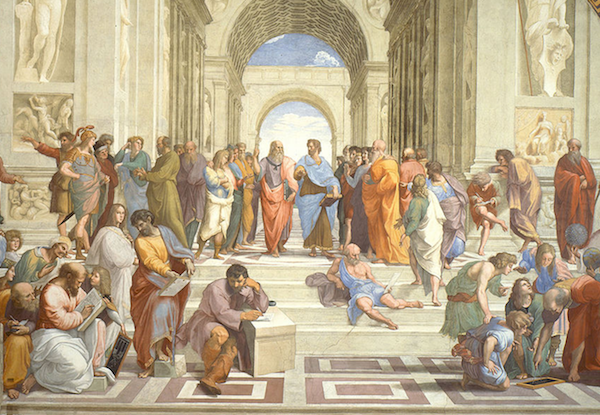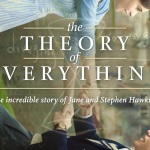The Stillbirth of Science in Greece
by Dr. Stacy Trasancos
Filed under Christianity and Science
NOTE: Today we continue our weekly series of essays by Dr. Stacy Trasancos on the "stillbirths" of science. They're based on Fr. Stanley L. Jaki's research into the theological history of science in the ancient cultures of Egypt, China, India, Babylon, Greece, and Arabia. See past articles here.
Like other great civilizations, the contributions and skill of the ancient Greeks cannot be dismissed. Probably more has been written about Greek intellectual history than any other ancient culture. Many scholars have credited ancient Greece with the invention of science, and Jaki held that they came closer to a birth of science than any other culture. There is a long list of scholars who left behind writings that inspire intellectual endeavors to this day. Here is a brief list of some of them.
Thales of Miletus (c. 620–c. 546 B.C.) was a geometer and astronomer influenced by the Babylonians and Egyptians. He developed ideas about abstract geometry such as the idea that the diameter of a circle bisects the circle and that base angles of isosceles triangles are equal.1 He is popularly credited as the “first scientist” even by those who admit that in the strict sense the recipient of this title is unknown because “science as a reliable method to knowledge, involving observation, hypothesis, experiment, and critique, would evolve.”2 Centuries later, Aristotleof Stagira, who will be discussed shortly, called Thales the “founder” of the type of philosophy that investigates the nature of matter and original causes.3 Thales was the founder of the school of thought known as Ionian physics. He conceived of the world of nature as an organism, an animal, within which were lesser organisms.4 The earth was, according to the Ionians, one such organism in the greater organism and it served its own purpose.
Anaximander of Miletus (c. 611–c. 547 B.C.) described the origin of all things as the “Boundless” or the “Unlimited” principle and was a speculative astronomer who wrote about celestial bodies and why the Earth does not fall.5 An Ionian following in the thought of Thales, Anaximander considered time and space as a matrix of birth to successive worlds.6 He thought that innumerable worlds arose in this boundless medium like bubbles and that the earth is but one of those bubbles. Ionian physics presupposed that all natural things were made of a single substance. Anaximander proposed that the cosmos was less like a god-like organism and more like a divine substance.7
Pythagóras of Sámios (c. 570–c. 490 B.C.) was a famous mathematician for the theorem named after him, and although the most authoritative history of early Greek geometry assigns him no role in geometry at all, his discoveries were significant nonetheless.8
Leucippus (fifth century B.C.) is considered the founder of Atomism, along with Democritus (c. 460–c. 370 B.C.) The theory of Atomism held that there could be no motion without voids and that invisible and indivisible particles moved in the empty space. Democritus called these particles ἄτομος or atomos, a term which is still used today. The theory was a philosophical one, not based on observation or experiment, to explain how there might be change without something coming to be out of nothing.9
Hippocrates of Cos (c. 450–c. 380 B.C.), among others, is credited with providing detailed medical observations that made it possible to diagnose and treat illness, along with a code of ethics that still has influence today.10 The Greeks borrowed from the Babylonian intellectual treasures, but they also developed their own system of geometry, without which the Babylonian data would have been unbeneficial.11 Modern geometers are still unable to reconstruct the demonstrations behind some propositions in the Fourteen Books of Euclid.12 Euclid of Alexandria (c. 325–265 B.C.) built a logical and rigorous geometry with a solid foundation, and it was a primary source of geometric reasoning and methods that went practically unchanged for more than two thousand years.13
There was, of course, the great Aristotle of Stagira (384–322 B.C.), the major Greek philosopher and student of the great Plato, the teacher who founded the Lyceum in Athens. Aristotle wrote stupendous volumes on logic, politics, biology, taxonomy, physics, and cosmology.14 The most mature form of science achieved during Hellenic times in the biological sciences was that of Aristotle’s. He turned zoology into a scientific discipline in his History of Animals and laid the foundations for comparative anatomy in his On the Parts of Animals. His On the Generation of Animals remained, until modern times, the authority on embryology.15
Jaki wrote that the “extraordinary feats of Aristotle in biology were in a sense responsible for his failure in physics.”16 According to Jaki, Aristotle’s On the Heavens “set the fate and fortune of science, or rather tragic misfortunes, for seventeen hundred years” because a serious error was made and went unnoticed in Aristotle’s continuous resort to biological simile.17 In holding the belief that all things had a soul and therefore sought the final cause for which they were best suited (i.e. rocks desire to fall to the ground), for animals as well as for objects, a purpose was assumed for processes and phenomena of every kind.
Aristotle asserted that if two bodies were dropped from the same height at the same time, the one with twice the weight of the other one would fall twice as fast because it had twice the nature and twice the desire to do so.18 Even though simple observation would prove that false, the hold on the mind of the Greeks of this animistic orthodoxy would not allow it. The Greeks thought of motion as a function of the magnitude, a “striving,” in nature for objects living and non-living. Aristotle dismissed the idea of unresisted motion as unreal or over-abstract.19 This orthodoxy caused even a genius like Aristotle to be so wrong about the free fall of objects. It is perplexing that no one noticed this falsehood in daily life, not just among the ancient Greeks but, as will be discussed later, also among those who followed Aristotle’s orthodoxy into the thirteenth and fourteenth centuries.
These views were—as has been noted in the Egyptian, Chinese, Indian, and Babylonian cultures already—the result of pantheism. The Greeks were steeped in the perspective of eternal cycles of birth-life-death-rebirth for all things, a theme common to all the great religions and cultures that experienced a stillbirth of science. In keeping with the mindset of Babylonian and Egyptian cultures, the Greeks also put a strong emphasis on an eternal, cyclic universe and on the comparison of the cosmos to animals. Even the ones with a belief in a monotheistic deity believed that deity was the universe and that all existence was a cyclic “cosmic treadmill.”
With Plato, Socrates, and Aristotle, the sublunary world was like a huge animal breathing, growing, and decaying in cycles of birth, death, and rebirth for eternity.20 The basis of this belief was that fundamentally all existence was viewed as cyclical and the cosmos either was a god-organism or a god-substance obeying unpredictable laws of its own volition and from which finite substances came into and out of existence. In subsequent centuries, even as new ideas about the nature of the cosmos were explored, the fundamental cyclical presumption remained. Philolaus, Alcmeon, Archytas, and Oenipodus were Pythagoreans who promoted a cyclical constitution of the universe.21 This belief was not irrational since human experience is based on cycles in life, in nature, and in the heavens.
Plato, in his many dialogues, told of a cosmic process that alternated between two phases, one of divine laws with a golden age and one of chaos and destruction. In Republic, Plato explains how he saw everything, including human and social phenomenon and the periodicity of human societies, under the organic cosmic law of cycles.22
"A city which is thus constituted can hardly be shaken; but, seeing that everything which Hard in truth it is for a state thus constituted to be shaken and disturbed; but since for everything that has come into being destruction is appointed, not even such a fabric as this will abide for all time, but it shall surely be dissolved, and this is the manner of its dissolution. Not only for plants that grow from the earth but also for animals that live upon it there is a cycle of bearing and barrenness for soul and body as often as the revolutions of their orbs come full circle, in brief courses for the short-lived and oppositely for the opposite; but the laws of prosperous birth or infertility for your race, the men you have bred to be your rulers will not for all their wisdom ascertain by reasoning combined with sensation, but they will escape them, and there will be a time when they will beget children out of season."23
This cycling between chaos and divine order came to be called the Great Year (sometimes Perfect Year), the time when all the stars and constellations of the sky came back to the position they were in a golden age of perfection, the period of one complete cycle of the equinoxes, although that date was figured differently by different philosophers and thus was ambiguous.24 However, the general point is that the notion of a cyclical eternity was prevalent and persistent in Greek thought. In Timaeus, Plato describes this Great Year:
"Thus arose day and night, which are the periods of the most intelligent nature; a month is created by the revolution of the moon, a year by that of the sun. Other periods of wonderful length and complexity are not observed by men in general; there is moreover a cycle or perfect year at the completion of which they all meet and coincide . . . To this end the stars came into being, that the created heaven might imitate the eternal nature."25
The gods, according to Plato and the Greeks, were themselves made in the form of a circle, the “most perfect figure and the figure of the universe.” According to Aristotle, time itself was, therefore, a circle.26 If time is a circle and the cosmos eternal within this circle, emanating from the pantheistic God, the nature of the gods, un-aging, un-alterable, and un-modified, then all change, including human knowledge, is cyclical too. For the most brilliant scholar or the least accomplished servant, the Greeks believed the same thoughts are recurring over and over again, and Aristotle held that this was, in fact, what man experienced:
"The mere evidence of the senses is enough to convince us of this, at least with human certainty. For in the whole range of time past, so far as our inherited records reach, no change appears to have taken place either in the whole scheme of the outermost heaven or in any of its proper parts. The common name, too, which has been handed down from our distant ancestors even to our own day, seems to show that they conceived of it in the fashion which we have been expressing. The same ideas, one must believe, recur in men’s minds not once or twice but again and again."27
Jaki described the psychological impact of this premise as complacency. Such a belief hardly inspired an intellectual curiosity or confidence to learn and dominate the physical laws of nature, even if one felt that he was living in a golden age.
"Clearly, if one is consciously merged into the treadmill of eternal recurrences, only two choices remain. One is that of hopelessness, the feeling that one is at the bottom. The other is complacency, the illusion that one is and remains on top, at least in the sense that the irreversible decline will begin to be felt only by one’s distant progeny. Both attitudes cry out for salvation, although the second may be the less receptive to it."28
The psychological impact is inherently tied to the cyclic worldview and the Great Year. Even in times of great progress, such as the Greek civilizations experienced, there would have been a resignation that the human cannot escape whatever fate pantheism and animism held for him. In eras of despair, there would have been a resignation to wait it out, even beyond one’s lifetime.
Next week is the final week, Arabia.
Related Posts
Notes:
- Dirk L. Couprie, “How Thales Was Able to ‘Predict’ a Solar Eclipse Without the Help of Alleged Mesopotamian Wisdom,” Early Science and Medicine Vol. 9, No. 4 (2004), 321-337. ↩
- Robert McHenry, “Thales of Miletus: The First Scientist, the First Philosopher,” Encyclopedia Britannica Blog, at Encyclopedia Britannica, Inc,. ↩
- Aristotle, Metaphysics, Book 1, Part 3. ↩
- Robin George Collingwood, The Idea of Nature (Oxford: Oxford University Press, 1945), 30. ↩
- Dirk L. Couprie, “Anaximander,” Internet Encyclopedia of Philosophy (2001/2005). ↩
- Collingwood, 33. ↩
- Collingwood, 35-36. ↩
- Carl Huffman, "Pythagoras", The Stanford Encyclopedia of Philosophy (Fall 2011 Edition), Edward N. Zalta (ed.). ↩
- Sylvia Berryman, “Leucippus,” The Stanford Encyclopedia of Philosophy (Fall 2010 Edition), Edward N. Zalta (ed.); Sylvia Berryman, "Democritus," The Stanford Encyclopedia of Philosophy (Fall 2010 Edition), Edward N. Zalta (ed.). ↩
- Michael Boylan, “Hippocrates,” Internet Encyclopedia of Philosophy (2002/2005). ↩
- Stanley L. Jaki, The Savior of Science (Grand Rapids, MI: William B. Eerdmans Publishing Company, 2000), 39. ↩
- Jaki, Savior of Science, 40; for example see, Edward Grant, A Source Book in Medieval Science (Cambridge, MA: Harvard University Press, 1974), 159, Footnote 7 about irrational ratios. ↩
- Christian Marinus Taisbak, “Euclid,” Encyclopedia Britannica (2013). ↩
- Christopher Shields, "Aristotle," The Stanford Encyclopedia of Philosophy (2013), Edward N. Zalta (ed.). ↩
- Stanley L. Jaki, Science and Creation: From Eternal Cycles to an Oscillating Universe (Edinburgh: Scottish Academic Press, Ltd, 1986), 104. ↩
- Jaki, Science and Creation, 104. ↩
- Jaki, Savior of Science, 40; Jaki, Science and Creation, 105. ↩
- Aristotle, On the Heavens, Book 1, Part 6, third paragraph, “…“if one weight is twice another, it will take half as long over a given movement.” ↩
- Stephen Toulmin, Foresight and Understanding: An Enquiry into the Aims of Science (New York, NY: Harper & Row, 1961), 51. ↩
- Jaki, Science and Creation, 105. ↩
- Jaki, Science and Creation, 106. ↩
- Jaki, Science and Creation, 110. ↩
- Plato, The Republic, translated by Paul Shorey. Volume II (Cambridge, MA: Cambridge University press, 1942), 245-247. ↩
- James Adams, The Republic of Plato: Edited with Critical Notes, Commentary, and Appendices. Second Edition. Volume II. Books VI-X and Indexes (Cambridge, MA: Cambridge University Press, 1963), 303-304. ↩
- Plato, Republic, 245-247. ↩
- Jaki, Science and Creation, 130. ↩
- Aristotle, On the Heavens, Book I, Part 3. ↩
- Jaki, Savior of Science, 44. ↩
Note: Our goal is to cultivate serious and respectful dialogue. While it's OK to disagree—even encouraged!—any snarky, offensive, or off-topic comments will be deleted. Before commenting please read the Commenting Rules and Tips. If you're having trouble commenting, read the Commenting Instructions.













